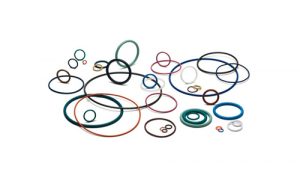Why Can O-rings Fail? The Most Common Reasons
Jan 12, 2020
 O-rings are a tried and trusted method of sealing two component parts in a wide range of industries that have been relied upon for well over a century. However, just because they are an excellent solution to a universal challenge, that doesn’t mean that they aren’t susceptible to failure on occasion.
O-rings are a tried and trusted method of sealing two component parts in a wide range of industries that have been relied upon for well over a century. However, just because they are an excellent solution to a universal challenge, that doesn’t mean that they aren’t susceptible to failure on occasion.
There are many different reasons why an O-ring might become damaged and the seal it is protecting become compromised. Here is a quick rundown of the five most common contributing factors to an O-ring failure, as well as advice on how to determine which problem is responsible and how to rectify it.
Abrasion
- Symptoms: O-rings which suffer from abrasion might have a rough or disfigured surface, while in extreme cases there may be ruptures or lacerations in the outer ring.
- Cause: One of the most common forms of O-ring failure, abrasion is caused by too much contact between the O-ring surface and the surrounding architecture. This can happen when not enough lubricant is used or when alien substances infiltrate the gland.
- Solution: Correct use of appropriate lubricant normally solves the problem, while the use of scraper rings may be necessary to prevent contaminants from entering the gland.
Chemical corruption
- Symptoms: Blisters, discolouration, lacerations and swelling can all be indicative that the O-ring has become exposed to chemicals with which it is not compatible.
- Cause: Exposure to certain chemicals can result in reactions with some type of elastomers. Depending on the O-ring material and the chemical in question, this can lead to reduced flexibility, strength and cross-link density, while swelling often incurs extrusion and seal failure.
- Solution: It’s essential that the right type of O-ring material is used for the right application. Many substances boast high resistance to chemicals; be sure to choose one of these if exposure is a concern.
Compression set
- Symptoms: Once removed from the gland, an O-ring should return to its original O-ring shape. However, those which have taken on a “set” will retain characteristics of the gland even after use, including flattened surfaces instead of circular ones.
- Cause: O-rings can lose their resilience and ability to return to their original form after exposure to extreme temperatures, through prolonged use or being fitted in incorrect groove geometry.
- Solution: Selecting an O-ring material with a low compression set or a high tolerance to extreme temperatures should ensure that the O-ring has a longer life. Ensuring the correct amount of pressure is being exerted on the O-ring, by using correct groove dimensions, is also key to avoiding compression set.
Extrusion/nibbling
- Symptoms: The surface edges of the O-ring have a chipped or frilly appearance and it may seem to be peeling away from the material underneath.
- Cause: Prolonged exposure to high amounts of pressure or repeated bursts of intense pressure can force an O-ring into the clearance gap between the two mating surfaces. In dynamic applications, the movement can then erode the O-ring’s surface, resulting in extrusion and nibbling.
- Solution: Using the correct size of O-ring is the most important precaution when avoiding extrusion and nibbling, but minimising the appearance and size of clearance gaps and selecting a hardier material for the O-ring can also help.
Thermal damage
- Symptoms: Two types of thermal damage can afflict O-rings: degradation and extrusion. The former will exhibit cracks and fissures on the O-ring’s surface, as well as a shinier aspect on occasion. The latter will result in the same symptoms outlined for extrusion and nibbling above.
- Cause: Both thermal degradation and thermal extrusion are caused by elevated temperatures. The former comes about when the temperature exceeds the O-ring elastomer’s upper threshold, while the latter occurs when the O-ring’s tolerance level is higher than the surrounding materials.
- Solution: The gland should be developed to withstand the same temperatures as the O-ring, while selecting the right material for the O-ring itself is also key to circumventing this problem.
